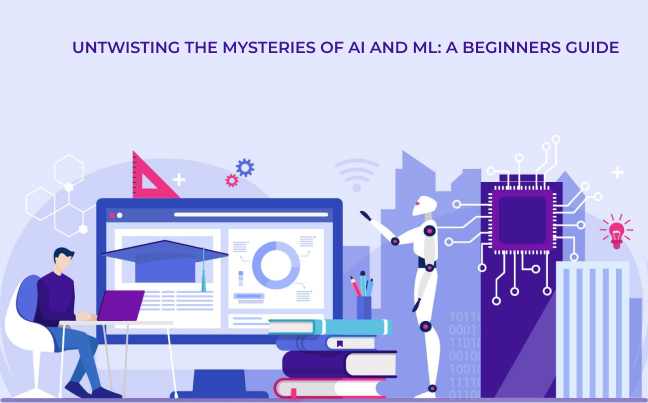Introduction
Everyone is talking about Artificial intelligence and Machine learning. But what are they? These buzzwords drive talks across industries, from tech giants to startups and everything in between. However, many people need clarification on the complexities of AI and ML, leaving them wondering: What exactly are AI and machine learning?
In this beginner’s guide, we’ll break down the complexity, clarify the terms, and give you a solid foundation for managing the ever-changing landscape of artificial intelligence and machine learning.
What is AI (Artificial Intelligence)?
Artificial intelligence (AI) is the reproduction of human intellect in machines that are built to perform human cognitive processes such as learning, problem-solving, and decision-making. AI allows computers to execute activities that would normally require human intellect, such as understanding natural language, identifying patterns in data, and making predictions based on previous experiences. There are several methods for approaching AI, such as:
Narrow AI: Also referred to as Weak AI, Narrow AI is intended to carry out a single task or a limited number of tasks. Virtual assistants such as Siri and Alexa and recommendation systems employed by streaming services and e-commerce platforms are a few examples.
General AI: Also referred to as Strong AI or Artificial General Intelligence (AGI), General AI is a hypothetical kind of artificial intelligence (AI) that is analogous to humans in that it can comprehend, learn, and apply intellect to a variety of jobs.
Artificial superintelligence: This is the term for AI that is infinitely more intelligent and capable than humans. It is theoretical, but researchers and futurists are debating and speculating about it.
What is Machine Learning?
A branch of artificial intelligence called machine learning (ML) focuses on creating models and algorithms that let computers learn from data and make decisions without explicit programming. ML essentially gives machines the ability to learn from their experiences and gradually get better at what they do.
There are a variety of machine learning algorithms, including:
Supervised Learning:
In supervised learning, the system is trained on labeled data, with each input assigned a corresponding output. The algorithm learns to predict or classify by generalizing from labeled examples presented during training.
Unsupervised Learning:
In unsupervised learning, the algorithm is given unlabeled data and is tasked with identifying hidden patterns or structures within it. Clustering, dimensionality reduction, and association rule learning are all commonly used techniques.
Reinforcement Learning:
Reinforcement learning trains an algorithm to make decisions by interacting with its surroundings and receiving feedback in the form of rewards or punishments. The goal is to learn a policy that maximizes the total reward over time.
The Future of AI and Machine Learning: What’s Next?
The future of AI and machine learning promises dramatic breakthroughs in a variety of businesses and facets of daily life. As technology advances, AI and machine learning are expected to play an increasingly important role in creating our reality.
AI and machine learning have several uses, ranging from tailored healthcare solutions and self-driving cars to increased cybersecurity measures and predictive analytics. These technologies have the potential to change the way businesses run, people engage with technology and society as a whole.
As AI and machine learning research and development progresses, we should expect to see progressively more advanced algorithms, smarter systems, and new applications emerge, pushing advancement, efficiency, and innovation across all industries.
Overall, the future of AI and machine learning has enormous potential to revolutionize our environment and promote positive change for decades to come.
Final Thoughts
By carefully leveraging the power of AI and machine learning, we can create new opportunities for innovation and advancement, paving the path for a brighter, more interconnected future. With collaboration, creativity, and a dedication to ethical development, the potential for AI and machine learning is endless in the next years.
Have an Idea? Let’s Shape It!
Kickstart your tech journey with a personalized development guide tailored to your goals.
Discover Your Tech Path →Share with your community!
Latest Articles

How Algorithmic Trading Works in 2026 | The Anatomy of Automated Money
Exclusive Key Takeaways: Definition:Algorithm-based trading is a computerized trading mechanism that helps trade buy and sell on exchanges, following strict…

Trading System Architecture 2026 | From Microservices to Agentic Mesh
Exclusive Key Takeaways: Agentic mesh replaces microservices to minimize network hop latency. Edge-native compute moves execution logic closer to exchange…

Trading Platform Development | Cost vs. ROI in 2026
Introduction - The Real Price of Building a Trading Platform in 2026 There is uneasiness among investors worldwide. The uncertainty…


